
Armstrong Siddeley Heritage Trust
Project Amethyst
The Amethyst Affair.
The year was 1953 and something needed to be done, the 346 Sapphire had replaced the 16-18hp range of cars which left a gap for a smaller more agile model. Cyril Siddeley took charge of a project to fill the gap and the model which became known as the 234/6 was the eventual outcome, however, it seems to be have been known originally as the Amethyst, a fact that came to light when the Heritage Trust was scanning in some old Armstrong Siddeley factory negatives bearing the recorded details.
The first negatives show the Amethyst 25th July 1953 on test at Silverstone on 25th July 1953, indeed the factory publicity team were kept busy taking many photos of the new range as it progressed through large and small changes.
%203%20by%202.jpg)


These pictures showing a vehicle that had obviously been in secret design and development for some time. The first picture shows the car now being thoroughly tested for road holding, speed and general performance. The second picture shows the car being refuelled from cans which clearly indicates that this task was definitely the preserve of the secretive Experimental department. The final picture is an excellent shot of the car at rest giving us the opportunity to compare in our mind's eye with what we would recognise as a 234/236 car today. Perhaps the most defining feature is the rear haunch created by the defining line rearwards from the middle of the back passenger door. Fortunately the factory publicity team were kept busy taking many photos of the new range as it progressed through large and small changes.
Testing complete, the company were now ready to take the next steps in preparation for future production. First the chassis is pictured here in August 1954, which seems believable as a complete 'Amethyst' car was constructed and was being road tested by October 1954. All of the dates we have to guide us are from the photographic envelopes as marked by the factory. In all honesty, there are anomalies, but in general they have proved logical and are the best indicator of past activities that we have.
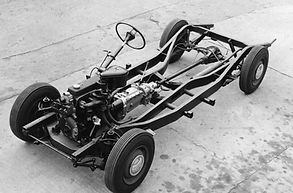


Picture one above of the chassis we note that, as with the 346 cars, the rear section curves over the rear axle, unlike the previous 16/18 range which dipped below. The umbrella grip hand brake is shown but this would be replaced with a more fashionable central lever between the front seats. The gearbox and overdrive unit on this six cylinder chassis has two electrical connections as used on the manumatic version. The shaft of the remote located gear lever required two versions, solid as you would expect for all but the manumatic which was in effect a tube in order to carry the wiring to the system's activating gear knob.
Picture two and three, recorded as being taken in October 1954, show what is perhaps best described as the essence of the 'Amethyst' design. From this point forward experimental and permanent changes would be made culminating in the heightened roofline in the final production models.
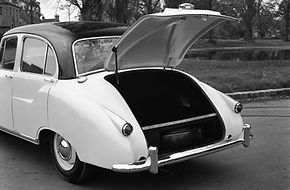


Picture one above shows the boot space of the original Amethyst prototype car. Picture two dated November 1954 shows a second prototype with the amended layout for the spare wheel which has been moved to allow tool storage space and also the location of the fuel tank placed behind the rear passenger seat. The chrome plated filler cap has been replaced by an under flap type and the rear lights and wing shape have been greatly modified.
The final picture shows that modifications have also been made to the front of the car and it is noticeable that a cost saving exercise is in progress as the head and spot lights are as those used for the 346 cars. Note also these air grills are the right angled corner type.
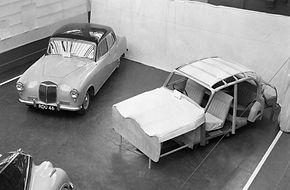
22_5_1955_InPixio.jpg)
%2022_5_1955_InPixio_InPixio.jpg)
Picture one dated March 1955 is of a factory showing of the new Mk 2 346 Sapphire cars, also the 'Ameythst' with an example of one of the mock-ups used in the development work is on show. Marked as the '2.3 litre Prototype Mk1' still no mention is made of the project name.
Picture two was taken on the 22nd of May 1955 and is the first of two visits to the village of Meriden. It seems that on this occasion that the driver, photographer and a young lady were sourcing suitable venues for publicity shots. The car was at this time bearing the Amethyst badge on the boot lid.
Picture three shows an Amethyst badge on the boot of the car, which would seem to indicate that this was to be the name for the new small Armstrong Siddeleys. However, by the November Motor Showtime, these cars would be known as 234/236 Sapphires.
%20%2020_6_1955_InPixio%202MP%20compressed.jpg)
%20%2020_6_1955_InPixio%20cun.jpg)

On the 20th of June 1955 the second visit was made to Meridon consisting of driver, photographer and a gentleman who can just be seen when the image is enlarged sitting in the back. He is wearing a jacket, light coloured shirt and a bow tie. It would be intriguing to think that this might be a glimpse of Terence Cuneo the now famous artist, who prepared the painting used so much in the promotion of this new range of cars. The final picture is a reminder of his work


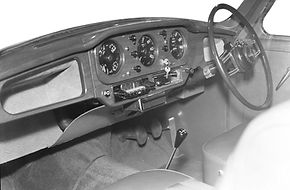
Picture one, factory records tell us that Meriden was again the venue of choice in April of the following year. This time badged a 234 Sapphire, having wire wheels and air grills that now have rounded corners. There are small sidelights and a repeater flasher is fitted just ahead of the A-pillar.
Picture two shows the engine bay of the 234 car. Note the twin SU carburettors. This was a break away from the carburettors usually fitted to Armstrong cars of the period. Perhaps a concession to the projected sporty image of this model and ever mindful of the competition.
The final picture shows that the cabin of the 234 was a pleasant place to be. Comfortable with adjustable, separate driver and passenger seats, A comprehensive dash showing essential engine states, speedometer and rev counter, radio, heater controls and the convenience of a clock, four-speed gearbox and to the right of the adjustable steering column the overdrive switch which operated on third and top gears.
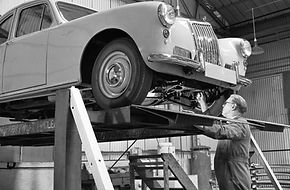


Picture one is of a 236 receiving it's final testing, checking and finishing, which in the 1950s was carried out at the Ansty site, before being passed to the final section for cleaning and polishing for onwards transfer to a dealer.
The centre publicity picture demonstrates the luggage caring capacity of the car. It is interesting to note that this production car has lost the fule fillet covering flap and now sits proud of the bodywork. Also, the fuel tank has been made flatter and thinner so that the boot floor is now flat.
The final picture in this series is something of a mystery, there are rumours that an open-top version was produced at the Parkside works could this be such a car. It's a pity that there wasn't a convertible version to replace the popular 16/18hp Hurricane.
One final thought, why did Armstrong Siddeley abandon the name Amethyst in favour of the Sapphire a name that was already applied to the 346 model.
